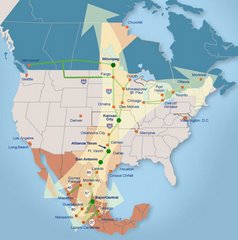
Bush Administration Quietly Plans NAFTA Super Highway
Headlines like the one above are popping up all over now days. Consider this and it's no surprise that the Federal Highway Administration (FHA) tried to influence Texas legislators not to pass HB 1892 (the TTC moratorium bill now on Gov. Perry's desk). Their actions sparked a sequence of interesting correspondence.
1) A copy of Federal correspondence to TxDOT can be found here. TxDOT then pushed on Texas legislators to kill HB 1892 by using Federal leverage.
2) May 1, 2007, their letter prompted a response from U.S. Senator Hutchison (here) expressing concern.
3) May 9, 2007 FHA replied to Senator Huchison (here).
So let's say this NAFTA Super Highway (TTC) plan by the Bush Administration is true. It could be possible Bush and Perry discussed this plan in the late 1990s when Bush and Perry were both in the Texas Gov. office. There was still plenty of work to do since some texas laws would have to be "modified" to allow for the TTC.
Interestingly enough, All 3 Texas Parties Officially Oppose the TTC. Yet, as we see, no party is willing to stop it. There are a lot of powerful people pushing this Highway with a lot of money to be made. The Bush Administration has remained quite publicly, but it appears they are working hard in the background to lay the foundations that connect Mexico to Canada.
From "Bush Administration Quietly Plans NAFTA Super Highway":
- NASCO, the North America SuperCorridor Coalition Inc. has received $2.5 million in earmarks from the U.S. Department of Transportation to plan the NAFTA Super Highway as a 10-lane limited-access road (five lanes in each direction) plus passenger and freight rail lines running alongside pipelines laid for oil and natural gas. One glance at the map of the NAFTA Super Highway on the front page of the NASCO website will make clear that the design is to connect Mexico, Canada, and the U.S. into one transportation system.
- Kansas City SmartPort Inc. is an “investor based organization supported by the public and private sector” to create the key hub on the NAFTA Super Highway.
- The U.S. government has housed within the Department of Commerce (DOC) an “SPP office” that is dedicated to organizing the many working groups laboring within the executive branches of the U.S., Mexico and Canada to create the regulatory reality for the Security and Prosperity Partnership. The SPP agreement was signed by Bush, President Vicente Fox, and then-Prime Minister Paul Martin in Waco, Tex., on March 23, 2005. According to the DOC website, a U.S.-Mexico Joint Working Committee on Transportation Planning has finalized a plan such that “(m)ethods for detecting bottlenecks on the U.S.-Mexico border will be developed and low cost/high impact projects identified in bottleneck studies will be constructed or implemented.” The report notes that new SENTRI travel lanes on the Mexican border will be constructed this year. The border at Laredo should be reduced to an electronic speed bump for the Mexican trucks containing goods from the Far East to enter the U.S. on their way to the Kansas City SmartPort.
- The Texas Department of Transportation (TxDOT) is overseeing the Trans-Texas Corridor (TTC) as the first leg of the NAFTA Super Highway. A 4,000-page environmental impact statement has already been completed and public hearings are scheduled for five weeks, beginning next month, in July 2006. The billions involved will be provided by a foreign company, Cintra Concessions de Infraestructuras de Transporte, S.A. of Spain. As a consequence, the TTC will be privately operated, leased to the Cintra consortium to be operated as a toll-road.















No comments:
Post a Comment